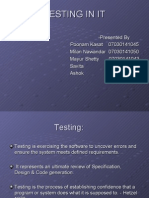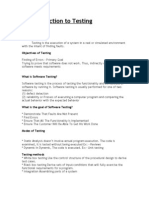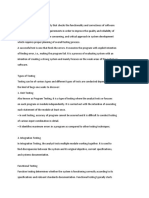Chapter-Testing: The Various Levels of Testing Are
Chapter-Testing: The Various Levels of Testing Are
Uploaded by
saikiran290692Copyright:
Available Formats
Chapter-Testing: The Various Levels of Testing Are
Chapter-Testing: The Various Levels of Testing Are
Uploaded by
saikiran290692Original Description:
Original Title
Copyright
Available Formats
Share this document
Did you find this document useful?
Is this content inappropriate?
Copyright:
Available Formats
Chapter-Testing: The Various Levels of Testing Are
Chapter-Testing: The Various Levels of Testing Are
Uploaded by
saikiran290692Copyright:
Available Formats
CHAPTER-
TESTING
The various levels of testing are:
1. White Box Testing
2. Black Box Testing
3. Unit Testing
4. Functional Testing
5. Performance Testing
6. Integration Testing
7. Objective
8. Integration Testing
9. Validation Testing
10. System Testing
11. Structure Testing
12. Output Testing
13. User Acceptance Testing
White Box Testing:
Execution of every path in the program.
Black Box Testing:
Exhaustive input testing is required to find all errors.
Unit Testing:
Unit testing, also known as Module Testing, focuses verification efforts on
the module. The module is tested separately and this is carried out at the
programming stage itself.
Unit Test comprises of the set of tests performed by an individual
programmer before integration of the unit into the system.
Unit test focuses on the smallest unit of software design- the software
component or module.
Using component level design, important control paths are tested to
uncover errors within the boundary of the module.
Unit test is white box oriented and the step can be conducted in parallel for
multiple components.
Functional Testing:
Functional test cases involve exercising the code with normal input values
for which the expected results are known, as well as the boundary values
Objective:
The objective is to take unit-tested modules and build a program structure
that has been dictated by design.
Performance Testing:
Performance testing determines the amount of execution time spent in
various parts of the unit, program throughput, and response time and
device utilization of the program unit. It occurs throughout all steps in the
testing process.
Integration Testing:
It is a systematic technique for constructing the program structure while at
the same time conducting tests to uncover errors associated with in the
interface.
It takes the unit tested modules and builds a program structure.
All the modules are combined and tested as a whole.
Integration of all the components to form the entire system and a overall
testing is executed.
Validation Testing:
Validation test succeeds when the software functions in a manner that can
be reasonably expected by the client.
Software validation is achieved through a series of black box testing which
confirms to the requirements.
Black box testing is conducted at the software interface.
The test is designed to uncover interface errors, is also used to demonstrate
that software functions are operational, input is properly accepted, output
are produced and that the integrity of external information is maintained.
System Testing:
Tests to find the discrepancies between the system and its original
objective, current specifications and system documentation.
Structure Testing:
It is concerned with exercising the internal logic of a program and
traversing particular execution paths.
Output Testing:
Output of test cases compared with the expected results created
during design of test cases.
Asking the user about the format required by them tests the output
generated or displayed by the system under consideration.
Here, the output format is considered into two was, one is on screen and
another one is printed format.
The output on the screen is found to be correct as the format was designed
in the system design phase according to user needs.
The output comes out as the specified requirements as the users hard
copy.
User acceptance Testing:
Final Stage, before handling over to the customer which is usually carried
out by the customer where the test cases are executed with actual data.
The system under consideration is tested for user acceptance and
constantly keeping touch with the prospective system user at the time of
developing and making changes whenever required.
It involves planning and execution of various types of test in order to
demonstrate that the implemented software system satisfies the
requirements stated in the requirement document.
Two set of acceptance test to be run:
1. Those developed by quality assurance group.
2. Those developed by customer.
TEST CASES :
USECASE
DESCRIPTION
EXPECTED
EVENT
OBSERVED
EVENT
RESULT
Mobile Installing the
application
Installation
sucessful
Installation
sucessful
Yes
Speak User interacts
through voice
Voice
recognition
Voice
recognition
Yes
Voice
activity
detector
Detects the user
voice
Detection of
voice
Voice
detected
Yes
Automatic
speech
recognition
Converts speech to
text
Text is
obtained
Text is
obtained
Yes
Conversatio
nal engine
Extract exact
meaning
Command
obtained
Command
obtained
Yes
Text to
speech
Converts the
acknowledgement
from text to voice
Acknowledge
ment is
obtained in
form of voice
Acknowledge
ment is
obtained in
form of voice
Yes
You might also like
- ISTQB Certified Tester Foundation Level Practice Exam QuestionsFrom EverandISTQB Certified Tester Foundation Level Practice Exam QuestionsRating: 5 out of 5 stars5/5 (1)
- Automated Software Testing Interview Questions You'll Most Likely Be AskedFrom EverandAutomated Software Testing Interview Questions You'll Most Likely Be AskedNo ratings yet
- Colt Pistol Model Mustang ExplainedDocument12 pagesColt Pistol Model Mustang Explainedcungya80% (5)
- System TestingDocument8 pagesSystem TestingGJASHGFANo ratings yet
- Food DonateDocument5 pagesFood DonatePremaNo ratings yet
- Test Cases 1Document8 pagesTest Cases 1Sachin KulkarniNo ratings yet
- New Microsoft Word DocumentDocument3 pagesNew Microsoft Word DocumentSiddhartha NagNo ratings yet
- System Testing TestingDocument3 pagesSystem Testing TestingatozdhiyanesNo ratings yet
- Basics of TestingDocument54 pagesBasics of TestingShruti MathurNo ratings yet
- Software Testing LevelsDocument12 pagesSoftware Testing LevelsnguyenduyhungNo ratings yet
- V&V - TestingDocument43 pagesV&V - Testingmahamd saiedNo ratings yet
- Testing in ITDocument21 pagesTesting in ITapi-19916368No ratings yet
- 6 TestingDocument5 pages6 Testingdeva702000No ratings yet
- System Testing Testing MethodologiesDocument8 pagesSystem Testing Testing MethodologiesAnonymous 22GBLsme1No ratings yet
- Introduction To TestingDocument30 pagesIntroduction To Testingkishore234No ratings yet
- Software Testing Strategy PDFDocument28 pagesSoftware Testing Strategy PDFJyotinagesh Singh100% (1)
- Operating System Act Like A Manager Between The System Hardware and Application Software. Also Do The Fallowing Task CPU Scheduling Memory Management Inter Process CommunicationDocument14 pagesOperating System Act Like A Manager Between The System Hardware and Application Software. Also Do The Fallowing Task CPU Scheduling Memory Management Inter Process CommunicationChaitanya KolluruNo ratings yet
- Module 4 NotesDocument29 pagesModule 4 NotesSuchith ReddyNo ratings yet
- Basic-Software-Testing - 28 03 2015Document29 pagesBasic-Software-Testing - 28 03 2015Tapas GhoshNo ratings yet
- Testing of Software: What Is Testing of Software?: VerificationDocument7 pagesTesting of Software: What Is Testing of Software?: Verificationgood shatNo ratings yet
- Types of Tests Unit Testing: System TestDocument4 pagesTypes of Tests Unit Testing: System TestSrinu ChowdaryNo ratings yet
- CH 7 - Software Quality AssuranceDocument34 pagesCH 7 - Software Quality Assurancehariye2225No ratings yet
- Cs502pc Se Unit 4Document14 pagesCs502pc Se Unit 4kingomsriNo ratings yet
- 6.1. TestingDocument12 pages6.1. TestingshubhamNo ratings yet
- Regression TestingDocument12 pagesRegression Testingkhalidubale85No ratings yet
- Chapter 5-System TestingDocument4 pagesChapter 5-System Testingzay sevNo ratings yet
- SE Chapter 7Document23 pagesSE Chapter 7Shafi EsaNo ratings yet
- SE Unit-04Document6 pagesSE Unit-04pish2922No ratings yet
- Differences Between The Different Levels of Tests: Unit/component TestingDocument47 pagesDifferences Between The Different Levels of Tests: Unit/component TestingNidhi SharmaNo ratings yet
- 3 Testing NotesDocument14 pages3 Testing NotessanjivkrkrisNo ratings yet
- Unit-4 Software EngineeringDocument40 pagesUnit-4 Software Engineeringharshitamakhija100No ratings yet
- Software Testing SefaDocument3 pagesSoftware Testing Sefashahalameenu2003No ratings yet
- Software TestingDocument39 pagesSoftware TestingTanzeel SialNo ratings yet
- Fundamental Design ConceptsDocument9 pagesFundamental Design ConceptsRajesh RamakrishnanNo ratings yet
- Oosad Notes Chap 7Document6 pagesOosad Notes Chap 7Leula BossNo ratings yet
- CIR 206 Group 5Document5 pagesCIR 206 Group 5wannabedaniel77No ratings yet
- 6.system TestingDocument4 pages6.system TestingViswanathan SNo ratings yet
- Software TestingDocument34 pagesSoftware Testingcosum kondoweNo ratings yet
- SE Unit 6Document50 pagesSE Unit 6sachinkhedkar051No ratings yet
- System TestingDocument3 pagesSystem Testingemmanuelpi007No ratings yet
- System TestingDocument3 pagesSystem TestingLakshmi AvadhanulaNo ratings yet
- Functional TestingDocument1 pageFunctional TestingJaneNo ratings yet
- Testing Tutorial LevelsDocument23 pagesTesting Tutorial LevelsDeepu JuluruNo ratings yet
- Test Cases JAvaDocument8 pagesTest Cases JAvaSrikanth SingamNo ratings yet
- Software TestingDocument3 pagesSoftware TestingStephen MainaNo ratings yet
- Unit 03Document25 pagesUnit 03Kamini SalunkheNo ratings yet
- CH - 7Document39 pagesCH - 7TedlamillionNo ratings yet
- Testing DefDocument8 pagesTesting Deflsvempati712No ratings yet
- Client-Server Application Testing Plan: EDISON Software Development CentreDocument7 pagesClient-Server Application Testing Plan: EDISON Software Development CentreEDISON Software Development Centre100% (1)
- TestingDocument5 pagesTestingmp8266511No ratings yet
- Software Testing StrategiesDocument12 pagesSoftware Testing Strategiesarunambrose2004No ratings yet
- Testing LatestDocument17 pagesTesting LatestMd. Fahim SahrierNo ratings yet
- Software Testing Methodologies and Types of TestingDocument3 pagesSoftware Testing Methodologies and Types of TestingClaire Martinez-MacalaladNo ratings yet
- Se 6Document10 pagesSe 6gcyvuNo ratings yet
- Testing: E-Commerce Application TestingDocument12 pagesTesting: E-Commerce Application TestingHimanshu SharmaNo ratings yet
- Contionous DeploymentDocument19 pagesContionous DeploymentdavidNo ratings yet
- Seunit 4Document21 pagesSeunit 4vandanargmeerutNo ratings yet
- Unit 3 Software TestingDocument21 pagesUnit 3 Software TestingTirth NarwalNo ratings yet
- Software Testing - LevelsDocument8 pagesSoftware Testing - LevelsEyoabNo ratings yet
- Swe 202: Introduction To Software Engineering: Chapter 8 (Part 1) Lecturer: Rand AlbrahimDocument19 pagesSwe 202: Introduction To Software Engineering: Chapter 8 (Part 1) Lecturer: Rand AlbrahimfatimaNo ratings yet
- Software Testing Interview Questions You'll Most Likely Be AskedFrom EverandSoftware Testing Interview Questions You'll Most Likely Be AskedNo ratings yet
- uCOS TheoryDocument5 pagesuCOS Theoryabhinav.gamerNo ratings yet
- Ch5 Tocci PDFDocument102 pagesCh5 Tocci PDFluenbcNo ratings yet
- XT2051 eDocument12 pagesXT2051 eale_dimmserviciosNo ratings yet
- Spare Parts List: Hydraulic BreakersDocument32 pagesSpare Parts List: Hydraulic BreakersMiguel RicapaNo ratings yet
- Dell Poweredge ServerDocument3 pagesDell Poweredge ServerSimlim SqNo ratings yet
- Combustion Research Unit CRU ToolDocument5 pagesCombustion Research Unit CRU ToolMachineryengNo ratings yet
- Price SCK SBY 25 MaretDocument10 pagesPrice SCK SBY 25 MaretsenopatirawuhNo ratings yet
- LSD1518 - Control Cloud Data Access Privilege andDocument5 pagesLSD1518 - Control Cloud Data Access Privilege andSwetha PattipakaNo ratings yet
- Control ValvesDocument38 pagesControl ValvesSridhar Gudapati100% (2)
- 5 6156650574445019895Document22 pages5 6156650574445019895Rony ArzalNo ratings yet
- Polito TemplateDocument30 pagesPolito TemplateschultzNo ratings yet
- Ficha Tecnica SentronicDocument14 pagesFicha Tecnica SentronicKarolay VelitoNo ratings yet
- Allfax 3000Document2 pagesAllfax 3000Miftakhul Mas'udNo ratings yet
- Microprocessor Systems I: Dara RahmatiDocument49 pagesMicroprocessor Systems I: Dara Rahmatimohammadreza aminiNo ratings yet
- DTMF ControlDocument10 pagesDTMF ControlPrateek PrakashNo ratings yet
- DSE8610 MKII Installation InstructionsDocument2 pagesDSE8610 MKII Installation InstructionsRafael FernandoNo ratings yet
- 14 Ab 3 FF 0Document13 pages14 Ab 3 FF 0adilwx30357No ratings yet
- 18Fxxx TutorialDocument6 pages18Fxxx TutorialAdrian ValdelamarNo ratings yet
- Purchase Order: Emerald Telcominfra Private Limited 0053 23-Oct-2020Document4 pagesPurchase Order: Emerald Telcominfra Private Limited 0053 23-Oct-2020Sourabh ShrivastavaNo ratings yet
- JauntPE 12steps ModifiedDocument2 pagesJauntPE 12steps Modifiedverpit100% (1)
- Call Center Interview QuestionsDocument5 pagesCall Center Interview QuestionsCeclie DelfinoNo ratings yet
- Labmanual ORCADDocument39 pagesLabmanual ORCADTraian SerbanNo ratings yet
- 7.06quotation of LP From Djs TechDocument1 page7.06quotation of LP From Djs Techabed.karakiNo ratings yet
- CS1000 Basic Programming: Computing Lab - IIDocument19 pagesCS1000 Basic Programming: Computing Lab - IIPartho BiswasNo ratings yet
- FLC Contisys Obd User Manual Ver5 0 0enDocument162 pagesFLC Contisys Obd User Manual Ver5 0 0enOctavio LópezNo ratings yet
- HUAWEI NXT-L09AC212B120 Software Upgrade GuidelineDocument10 pagesHUAWEI NXT-L09AC212B120 Software Upgrade GuidelineJose Luis PabloNo ratings yet
- Modul PBM 5 (Assembly)Document18 pagesModul PBM 5 (Assembly)Fajar FatahillahNo ratings yet
- 5 GAMP5 PharmOut 2008-07-11Document43 pages5 GAMP5 PharmOut 2008-07-11Rajiv Bhala100% (1)
- PIC18F2423Document392 pagesPIC18F2423Thanh Minh HaNo ratings yet

























































































